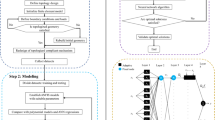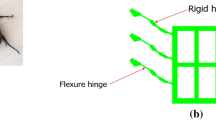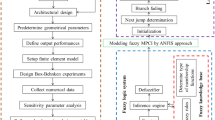Abstract
Modeling and optimization for compliant mechanisms are challenging tasks thanks to an unclear kinematic merging among rigid and flexible links. Hence, this paper develops a computational intelligence-based method for modeling and optimization. The proposed method concerns about statistics, numerical simulation, computational intelligence, and metaheuristics. A two degrees of freedom compliant mechanism is investigated to illustrate the effectiveness of the suggested computational intelligence method. First, numerical datasets are collected by simulations. Then, sensitivity of design parameters is analyzed by analysis of variance and Taguchi technique. The results of sensitivity are employed to separate a few populations for lightning attachment procedure optimization (LAPO). Next, the values of two output performances of the mechanism are changed into the values in the range from zero to one through desirability function method. The calculated output values become two inputs of the fuzzy logic model, and the output of this system is a single objective function (SOF). Subsequently, the SOF is modeled by using adaptive neuro-fuzzy inference system (ANFIS). LAPO algorithm is then utilized to maximize the SOF. The results revealed that the numerical example 3 is the best design for the mechanism. In comparison with artificial intelligence techniques and regression, the results show that the performance indexes of the proposed ANFIS model (R2 close 1, MSE about 10–4, and RMSE about 10–2) are superior to those of the multilayer perceptron, deep neural network, and multiple-linear regression. Additionally, the proposed computational intelligence method is more effective than the Taguchi-fuzzy logic, ANFIS-integrated teaching learning-based optimization, and ANFIS-integrated Jaya in searching the optimal design of the compliant mechanism. The results determined that the optimal displacement and parasitic error are about 2.2109 mm and 0.0028 mm, respectively.











Similar content being viewed by others
Explore related subjects
Discover the latest articles, news and stories from top researchers in related subjects.References
Hao G, Kong X (2012) A novel large-range XY compliant parallel manipulator with enhanced out-of-plane stiffness. J Mech Des Trans ASME. https://doi.org/10.1115/1.4006653
Hao G (2017) Determinate synthesis of symmetrical, monolithic tip-tilt-piston flexure stages. J Mech Des Trans ASME. https://doi.org/10.1115/1.4035965
Choi K, Lee JJ, Kim GH et al (2018) Amplification ratio analysis of a bridge-type mechanical amplification mechanism based on a fully compliant model. Mech Mach Theory 121:355–372. https://doi.org/10.1016/j.mechmachtheory.2017.11.002
Parvari Rad F, Vertechy R, Berselli G, Parenti-Castelli V (2016) Analytical compliance analysis and finite element verification of spherical flexure hinges for spatial compliant mechanisms. Mech Mach Theory 101:168–180. https://doi.org/10.1016/j.mechmachtheory.2016.01.010
Qingsong X (2015) Design of asymmetric flexible micro-gripper mechanism based on flexure hinges. Adv Mech Eng 7:1–8. https://doi.org/10.1177/1687814015590331
Hao G (2018) A framework of designing compliant mechanisms with nonlinear stiffness characteristics. Microsyst Technol. https://doi.org/10.1007/s00542-017-3538-y
Hao G, Dai F, He X, Liu Y (2017) Design and analytical analysis of a large-range tri-symmetrical 2R1T compliant mechanism. Microsyst Technol 23:4359–4366
Riza M, Hao G (2019) A flexure motion stage system for light beam control. Microsyst Technol. https://doi.org/10.1007/s00542-018-4168-8
Tran NT, Le Chau N, Dao TP (2020) A new butterfly-inspired compliant joint with 3-DOF in-plane motion. Arab J Sci Eng. https://doi.org/10.1007/s13369-020-04415-8
Wang Y, Luo Z, Zhang X, Kang Z (2014) Topological design of compliant smart structures with embedded movable actuators. Smart Mater Struct. https://doi.org/10.1088/0964-1726/23/4/045024
Ling M, Cao J, Zeng M et al (2016) Enhanced mathematical modeling of the displacement amplification ratio for piezoelectric compliant mechanisms. Smart Mater Struct 25:1–11. https://doi.org/10.1088/0964-1726/25/7/075022
Cao J, Ling M, Inman DJ, Lin J (2016) Generalized constitutive equations for piezo-actuated compliant mechanism. Smart Mater Struct 25:1–10. https://doi.org/10.1088/0964-1726/25/9/095005
Hansen BJ, Carron CJ, Jensen BD et al (2007) Plastic latching accelerometer based on bistable compliant mechanisms. Smart Mater Struct. https://doi.org/10.1088/0964-1726/16/5/055
Chau NL, Tran NT, Dao T (2020) Design and Performance Analysis of a TLET-Type Flexure Hinge. Adv Mater Sci Eng. https://doi.org/10.1155/2020/8293509
Howell LL, Midha A (1994) A method for the design of compliant mechanisms with small-length flexural pivots. J Mech Des Trans ASME 116:280–290. https://doi.org/10.1115/1.2919359
Valentini PP, Cirelli M, Pennestrì E (2019) Second-order approximation pseudo-rigid model of flexure hinge with parabolic variable thickness. Mech Mach Theory. https://doi.org/10.1016/j.mechmachtheory.2019.03.006
Verotti M (2020) A pseudo-rigid body model based on finite displacements and strain energy. Mech Mach Theory 149:103811. https://doi.org/10.1016/j.mechmachtheory.2020.103811
Wang N, Zhang Z, Zhang X (2019) Stiffness analysis of corrugated flexure beam using stiffness matrix method. Proc Inst Mech Eng Part C J Mech Eng Sci 233:1818–1827. https://doi.org/10.1177/0954406218772002
Chen S, Ling M, Zhang X (2018) Design and experiment of a millimeter-range and high-frequency compliant mechanism with two output ports. Mech Mach Theory 126:201–209. https://doi.org/10.1016/j.mechmachtheory.2018.04.003
Teo TJ, Chen IM, Yang G, Lin W (2010) A generic approximation model for analyzing large nonlinear deflection of beam-based flexure joints. Precis Eng 34:607–618. https://doi.org/10.1016/j.precisioneng.2010.03.003
Ling M, Howell LL, Cao J, Chen G (2020) Kinetostatic and dynamic modeling of flexure-based compliant mechanisms: a survey. Appl Mech Rev. https://doi.org/10.1115/1.4045679
Lobontiu N (2002) Compliant mechanisms: design of flexure hinges. CRC Press, Boca Raton
Le ZhuW, Zhu Z, Guo P, Ju BF (2018) A novel hybrid actuation mechanism based XY nanopositioning stage with totally decoupled kinematics. Mech Syst Signal Process 99:747–759. https://doi.org/10.1016/j.ymssp.2017.07.010
Le ZhuW, Zhu Z, Shi Y et al (2016) Design, modeling, analysis and testing of a novel piezo-actuated XY compliant mechanism for large workspace nano-positioning. Smart Mater Struct 25:1–17. https://doi.org/10.1088/0964-1726/25/11/115033
Hao G, Kong X (2013) A normalization-based approach to the mobility analysis of spatial compliant multi-beam modules. Mech Mach Theory. https://doi.org/10.1016/j.mechmachtheory.2012.08.013
Hao G, Yu J (2016) Design, modelling and analysis of a completely-decoupled XY compliant parallel manipulator. Mech Mach Theory 102:179–195
Hao G, Li H (2016) Extended static modeling and analysis of compliant compound parallelogram mechanisms considering the initial internal axial force. J Mech Robot . https://doi.org/10.1115/1.4032592
Hao G, Li H (2015) Conceptual designs of multi-degree of freedom compliant parallel manipulators composed of wire-beam based compliant mechanisms. Proc Inst Mech Eng Part C J Mech Eng Sci. https://doi.org/10.1177/0954406214535925
Friedrich R, Lammering R, Rösner M (2014) On the modeling of flexure hinge mechanisms with finite beam elements of variable cross section. Precis Eng 38:915–920. https://doi.org/10.1016/j.precisioneng.2014.06.001
Albanesi AE, Pucheta MA, Fachinotti VD (2013) A new method to design compliant mechanisms based on the inverse beam finite element model. Mech Mach Theory. https://doi.org/10.1016/j.mechmachtheory.2013.02.009
Alkayem NF, Cao M, Zhang Y et al (2018) Structural damage detection using finite element model updating with evolutionary algorithms: a survey. Neural Comput Appl 30:389–411
Zhu B, Zhang X, Wang N (2013) Topology optimization of hinge-free compliant mechanisms with multiple outputs using level set method. Struct Multidiscip Optim 47:659–672. https://doi.org/10.1007/s00158-012-0841-1
Wang N, Zhang Z, Zhang X, Cui C (2018) Optimization of a 2-DOF micro-positioning stage using corrugated flexure units. Mech Mach Theory 121:683–696. https://doi.org/10.1016/j.mechmachtheory.2017.11.021
Liu M, Zhang X, Fatikow S (2016) Design and analysis of a high-accuracy flexure hinge. Rev Sci Instrum. https://doi.org/10.1063/1.4948924
Xu Q, Li Y (2011) Analytical modeling, optimization and testing of a compound bridge-type compliant displacement amplifier. Mech Mach Theory 46:183–200. https://doi.org/10.1016/j.mechmachtheory.2010.09.007
Dao TP, Huang SC (2017) Design and multi-objective optimization for a broad self-amplified 2-DOF monolithic mechanism. Sadhana Acad Proc Eng Sci 42:1527–1542. https://doi.org/10.1007/s12046-017-0714-9
Choi KB, Han CS (2007) Optimal design of a compliant mechanism with circular notch flexure hinges. Proc Inst Mech Eng Part C J Mech Eng Sci 221:385–392. https://doi.org/10.1243/0954406JMES312
Fossati GG, Miguel LFF, Casas WJP (2019) Multi-objective optimization of the suspension system parameters of a full vehicle model. Optim Eng 20:151–177. https://doi.org/10.1007/s11081-018-9403-8
Arasu MV, Arokiyaraj S, Viayaraghavan P et al (2019) One step green synthesis of larvicidal, and azo dye degrading antibacterial nanoparticles by response surface methodology. J Photochem Photobiol B Biol 190:154–162. https://doi.org/10.1016/j.jphotobiol.2018.11.020
Wang CY, Zhang YQ, Zhao WZ (2018) Multi-objective optimization of a steering system considering steering modality. Adv Eng Softw 126:61–74. https://doi.org/10.1016/j.advengsoft.2018.09.012
Güllü H, Fedakar Hİ (2017) Response surface methodology for optimization of stabilizer dosage rates of marginal sand stabilized with Sludge Ash and fiber based on UCS performances. KSCE J Civ Eng. https://doi.org/10.1007/s12205-016-0724-x
Jiang P, Wang C, Zhou Q et al (2016) Optimization of laser welding process parameters of stainless steel 316L using FEM, Kriging and NSGA-II. Adv Eng Softw 99:147–160. https://doi.org/10.1016/j.advengsoft.2016.06.006
Güllü H (2013) On the prediction of shear wave velocity at local site of strong ground motion stations: an application using artificial intelligence. Bull Earthq Eng. https://doi.org/10.1007/s10518-013-9425-8
Güllü H (2017) A new prediction method for the rheological behavior of grout with bottom ash for jet grouting columns. Soils Found. https://doi.org/10.1016/j.sandf.2017.05.006
Güllü H (2017) A novel approach to prediction of rheological characteristics of jet grout cement mixtures via genetic expression programming. Neural Comput Appl. https://doi.org/10.1007/s00521-016-2360-2
Güllü H, Fedakar Hİ (2017) On the prediction of unconfined compressive strength of silty soil stabilized with bottom ash, jute and steel fibers via artificial intelligence. Geomech Eng 12:441–464. https://doi.org/10.12989/gae.2017.12.3.441
Güllü H (2014) Function finding via genetic expression programming for strength and elastic properties of clay treated with bottom ash. Eng Appl Artif Intell. https://doi.org/10.1016/j.engappai.2014.06.020
Güllü H (2012) Prediction of peak ground acceleration by genetic expression programming and regression: a comparison using likelihood-based measure. Eng Geol. https://doi.org/10.1016/j.enggeo.2012.05.010
Güllü H, Erçelebi E (2007) A neural network approach for attenuation relationships: an application using strong ground motion data from Turkey. Eng Geol. https://doi.org/10.1016/j.enggeo.2007.05.004
Wang B, Moayedi H, Nguyen H et al (2019) Feasibility of a novel predictive technique based on artificial neural network optimized with particle swarm optimization estimating pullout bearing capacity of helical piles. Eng Comput. https://doi.org/10.1007/s00366-019-00764-7
Koopialipoor M, Fahimifar A, Ghaleini EN et al (2019) Development of a new hybrid ANN for solving a geotechnical problem related to tunnel boring machine performance. Eng Comput. https://doi.org/10.1007/s00366-019-00701-8
Macura L, Voznak M (2017) Multi-criteria analysis and prediction of network incidents using monitoring system. J Adv Eng Comput 1:29. https://doi.org/10.25073/jaec.201711.47
Wong EWC, Kim DK (2018) A simplified method to predict fatigue damage of TTR subjected to short-term VIV using artificial neural network. Adv Eng Softw 126:100–109. https://doi.org/10.1016/j.advengsoft.2018.09.011
Li Z, Shi K, Dey N et al (2017) Rule-based back propagation neural networks for various precision rough set presented KANSEI knowledge prediction: a case study on shoe product form features extraction. Neural Comput Appl. https://doi.org/10.1007/s00521-016-2707-8
Talaat M, Gobran MH, Wasfi M (2018) A hybrid model of an artificial neural network with thermodynamic model for system diagnosis of electrical power plant gas turbine. Eng Appl Artif Intell. https://doi.org/10.1016/j.engappai.2017.10.014
Ahmed SS, Dey N, Ashour AS et al (2017) Effect of fuzzy partitioning in Crohn’s disease classification: a neuro-fuzzy-based approach. Med Biol Eng Comput. https://doi.org/10.1007/s11517-016-1508-7
Ngan TT, Tuan TM, Son LH et al (2016) Decision making based on fuzzy aggregation operators for medical diagnosis from dental X-ray images. J Med Syst. https://doi.org/10.1007/s10916-016-0634-y
Mhetre NA, Deshpande AV, Mahalle PN (2016) Trust management model based on fuzzy approach for ubiquitous computing. Int J Ambient Comput Intell. https://doi.org/10.4018/IJACI.2016070102
Bandyopadhyay S, Das S, Datta A (2020) A hybrid fuzzy filtering—fuzzy thresholding technique for region of interest detection in noisy images. Appl Intell. https://doi.org/10.1007/s10489-019-01551-z
Moayedi H, Raftari M, Sharifi A et al (2019) Optimization of ANFIS with GA and PSO estimating α ratio in driven piles. Eng Comput. https://doi.org/10.1007/s00366-018-00694-w
Sreedhara BM, Rao M, Mandal S (2018) Application of an evolutionary technique (PSO–SVM) and ANFIS in clear-water scour depth prediction around bridge piers. Neural Comput Appl 6:1–15. https://doi.org/10.1007/s00521-018-3570-6
Le Chau N, Dao TP, Dang VA (2019) An efficient hybrid approach of improved adaptive neural fuzzy inference system and teaching learning-based optimization for design optimization of a jet pump-based thermoacoustic-stirling heat engine. Neural Comput Appl. https://doi.org/10.1007/s00521-019-04249-y
Costa NR, Lourenço J, Pereira ZL (2011) Desirability function approach: a review and performance evaluation in adverse conditions. Chemom Intell Lab Syst 107:234–244. https://doi.org/10.1016/j.chemolab.2011.04.004
Huang SC, Dao TP (2016) Multi-objective optimal design of a 2-DOF flexure-based mechanism using hybrid approach of grey-Taguchi coupled response surface methodology and entropy measurement. Arab J Sci Eng 41:5215–5231. https://doi.org/10.1007/s13369-016-2242-z
Dao T-P (2016) Multiresponse optimization of a compliant guiding mechanism using hybrid Taguchi-grey based fuzzy logic approach. Math Probl Eng. https://doi.org/10.1155/2016/5386893
Keshtiara M, Golabi S, Tarkesh Esfahani R (2019) Multi-objective optimization of stainless steel 304 tube laser forming process using GA. Eng Comput. https://doi.org/10.1007/s00366-019-00814-0
Chau NL, Le HG, Dao T et al (2019) Efficient hybrid method of FEA-based RSM and PSO algorithm for multi-objective optimization design for a compliant rotary joint for upper limb assistive device. Math Probl Eng. https://doi.org/10.1155/2019/2587373
Ding S, Du W, Zhao X et al (2019) A new asynchronous reinforcement learning algorithm based on improved parallel PSO. Appl Intell. https://doi.org/10.1007/s10489-019-01487-4
Dao T-P, Huang S-C, Le Chau N (2017) Robust parameter design for a compliant microgripper based on hybrid Taguchi-differential evolution algorithm. Microsyst Technol. https://doi.org/10.1007/s00542-017-3534-2
Ha MH, Vu QV, Truong VH (2020) Optimization of nonlinear inelastic steel frames considering panel zones. Adv Eng Softw 142:102771. https://doi.org/10.1016/j.advengsoft.2020.102771
Dao T-P, Huang S-C, Thang PT (2017) Hybrid Taguchi-cuckoo search algorithm for optimization of a compliant focus positioning platform. Appl Soft Comput J. https://doi.org/10.1016/j.asoc.2017.04.038
Qian S, Ye Y, Liu Y, Xu G (2018) An improved binary differential evolution algorithm for optimizing PWM control laws of power inverters. Optim Eng 19:271–296. https://doi.org/10.1007/s11081-017-9354-5
Mortazavi A, Toğan V, Moloodpoor M (2019) Solution of structural and mathematical optimization problems using a new hybrid swarm intelligence optimization algorithm. Adv Eng Softw 127:106–123. https://doi.org/10.1016/j.advengsoft.2018.11.004
Hsieh TJ (2020) Data-driven oriented optimization of resource allocation in the forging process using bi-objective evolutionary algorithm. Eng Appl Artif Intell. https://doi.org/10.1016/j.engappai.2019.103469
Senkerik R, Zelinka I, Pluhacek M (2017) Chaos-based optimization—a review. J Adv Eng Comput 1:68. https://doi.org/10.25073/jaec.201711.51
Zatloukal F, Znoj J (2017) Malware detection based on multiple PE headers identification and optimization for specific types of files. J Adv Eng Comput 1:153. https://doi.org/10.25073/jaec.201712.64
Chernogorov I, Polyakh V, Yarakhmedov O (2017) Search optimization opportunities of modified self-organizing migrating algorithm in multi-extremal tasks environment. J Adv Eng Comput 1:144. https://doi.org/10.25073/jaec.201712.60
Dinh-Cong D, Pham-Duy S, Nguyen-Thoi T (2018) Damage detection of 2D frame structures using incomplete measurements by optimization procedure and model reduction. J Adv Eng Comput 2:164. https://doi.org/10.25073/jaec.201823.203
Venkata Rao R (2016) Review of applications of TLBO algorithm and a tutorial for beginners to solve the unconstrained and constrained optimization problems. Decis Sci Lett 5:1–30. https://doi.org/10.5267/j.dsl.2015.9.003
Nenavath H, Jatoth RK (2018) Hybrid SCA–TLBO: a novel optimization algorithm for global optimization and visual tracking. Neural Comput Appl 6:1–30. https://doi.org/10.1007/s00521-018-3376-6
Niknam T, Azizipanah-Abarghooee R, Rasoul Narimani M (2012) A new multi objective optimization approach based on TLBO for location of automatic voltage regulators in distribution systems. Eng Appl Artif Intell. https://doi.org/10.1016/j.engappai.2012.07.004
Rao RV, Keesari HS, Oclon P, Taler J (2019) An adaptive multi-team perturbation-guiding Jaya algorithm for optimization and its applications. Eng Comput. https://doi.org/10.1007/s00366-019-00706-3
Nematollahi AF, Rahiminejad A, Vahidi B (2017) A novel physical based meta-heuristic optimization method known as lightning attachment procedure optimization. Appl Soft Comput J 59:596–621. https://doi.org/10.1016/j.asoc.2017.06.033
Howell LL, Magleby SP, Olsen BM (2013) Handbook of compliant mechanisms. Wiley, Hoboken
Derringer G, Suich R (1980) Simultaneous optimization of several response variables. J Qual Technol 12:214–219. https://doi.org/10.1080/00224065.1980.11980968
Díaz-Cortés MA, Cuevas E, Gálvez J, Camarena O (2017) A new metaheuristic optimization methodology based on fuzzy logic. Appl Soft Comput J 61:549–569. https://doi.org/10.1016/j.asoc.2017.08.038
Zhou J, Li C, Arslan CA et al (2019) Performance evaluation of hybrid FFA-ANFIS and GA-ANFIS models to predict particle size distribution of a muck-pile after blasting. Eng Comput. https://doi.org/10.1007/s00366-019-00822-0
Foroughi Nematollahi A, Rahiminejad A, Vahidi B (2019) A novel multi-objective optimization algorithm based on lightning attachment procedure optimization algorithm. Appl Soft Comput J 75:404–427. https://doi.org/10.1016/j.asoc.2018.11.032
Zheng T, Luo W (2019) An enhanced lightning attachment procedure optimization with quasi-opposition-based learning and dimensional search strategies. Comput Intell Neurosci 2019:1–24. https://doi.org/10.1155/2019/1589303
Howell LL, Midha A (1996) A loop-closure theory for the analysis and synthesis of compliant mechanisms. J Mech Des Trans ASME. https://doi.org/10.1155/1.2826842
Roshani GH, Karami A, Nazemi E (2019) An intelligent integrated approach of Jaya optimization algorithm and neuro-fuzzy network to model the stratified three-phase flow of gas–oil–water. Comput Appl Math. https://doi.org/10.1007/s40314-019-0772-1
Nhu VH, Hoang ND, Duong VB et al (2019) A hybrid computational intelligence approach for predicting soil shear strength for urban housing construction: a case study at Vinhomes Imperia project, Hai Phong city (Vietnam). Eng Comput. https://doi.org/10.1007/s00366-019-00718-z
Shang Y, Nguyen H, Bui XN et al (2019) A novel artificial intelligence approach to predict blast-induced ground vibration in open-pit mines based on the firefly algorithm and artificial neural network. Nat Resour Res. https://doi.org/10.1007/s11053-019-09503-7
Dao T-P, Huang S-C (2015) Design, fabrication, and predictive model of a 1-dof translational flexible bearing for high precision mechanism. Trans Can Soc Mech Eng 39:419–429
Kumar Y, Dubey AK, Arora RR, Rocha A (2020) Multiclass classification of nutrients deficiency of apple using deep neural network. Neural Comput Appl. https://doi.org/10.1007/s00521-020-05310-x
Ge Y, Wu H (2020) Prediction of corn price fluctuation based on multiple linear regression analysis model under big data. Neural Comput Appl. https://doi.org/10.1007/s00521-018-03970-4
Rao RV, Savsani VJ, Vakharia DP (2011) Teaching-learning-based optimization: a novel method for constrained mechanical design optimization problems. CAD Comput Aided Des 43:303–315. https://doi.org/10.1016/j.cad.2010.12.015
Rao RV, Rai DP, Ramkumar J, Balic J (2016) A new multi-objective Jaya algorithm for optimization of modern machining processes. Adv Prod Eng Manag. https://doi.org/10.14743/apem2016.4.226
Li LM, Di LuK, Zeng GQ et al (2016) A novel real-coded population-based extremal optimization algorithm with polynomial mutation: a non-parametric statistical study on continuous optimization problems. Neurocomputing. https://doi.org/10.1016/j.neucom.2015.09.075
García S, Molina D, Lozano M, Herrera F (2009) A study on the use of non-parametric tests for analyzing the evolutionary algorithms’ behaviour: a case study on the CEC’2005 special session on real parameter optimization. J Heuristics 15:617–644. https://doi.org/10.1007/s10732-008-9080-4
Acknowledgements
This research is funded by Vietnam National Foundation for Science and Technology Development (NAFOSTED) under Grant Number 107.01-2019.14.
Author information
Authors and Affiliations
Corresponding author
Ethics declarations
Conflict of interest
The authors declare that they have no conflict of interest.
Additional information
Publisher's Note
Springer Nature remains neutral with regard to jurisdictional claims in published maps and institutional affiliations.
Rights and permissions
About this article
Cite this article
Chau, N.L., Tran, N.T. & Dao, TP. Design optimization for a compliant mechanism based on computational intelligence method. Neural Comput & Applic 33, 9565–9587 (2021). https://doi.org/10.1007/s00521-021-05717-0
Received:
Accepted:
Published:
Issue Date:
DOI: https://doi.org/10.1007/s00521-021-05717-0




